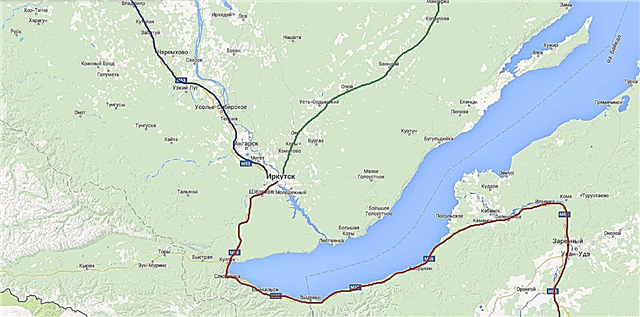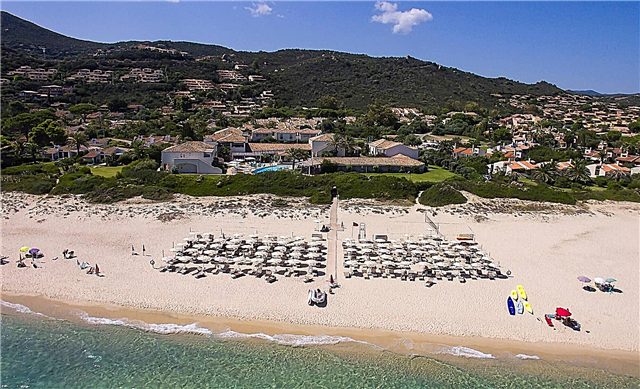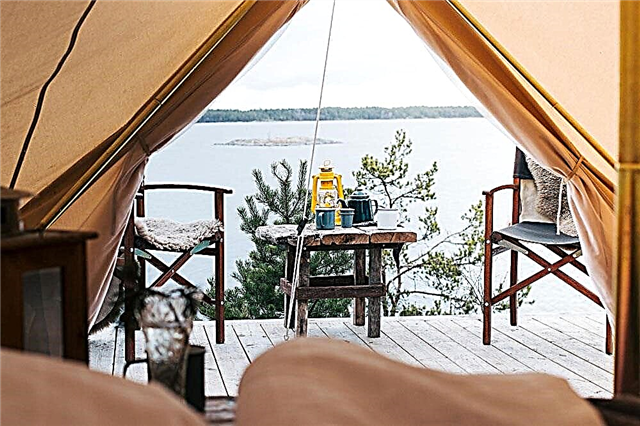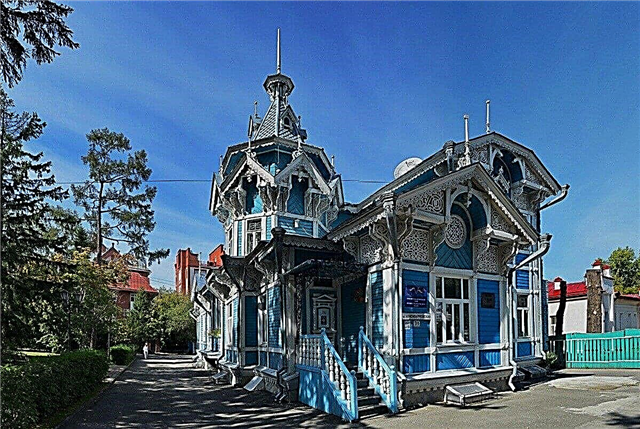First of all, the Tomsk region attracts with its real Siberian nature. Numerous rivers, cascades of lakes and bogs, endless taiga forests allow tourists to feel themselves in the place of pioneers who first set foot on this land more than 4 centuries ago. There are several nature reserves and many natural monuments in the region. The Talovskiye bowls, the system of the Vasyugan bogs, the Blue Cliff are magnificent. Moreover, the Tomsk region is recognized as the capital of the cedar, and the best souvenir from here is pine nuts.
Tomsk is on the list of historical settlements in Russia. Many of its buildings have the status of architectural monuments. And the wooden buildings of the city are a real open-air museum. The bizarre monuments of the capital are definitely worth mentioning. Among them - a monument to slippers, a football fan, a wooden ruble, fortunately, a janitor.
The most interesting and beautiful places in the region
List, photos with names and descriptions of the best attractions!
Wooden architecture of Tomsk
Wooden architecture of Tomsk is a historical phenomenon of the world scale. Nowhere else in the world are there such vast, artistically full-fledged arrays with a variety of wooden structures. These are houses in the style of Classicism, Art Nouveau, Empire mansions. They were built from the moment the city was founded until the revolution itself. Among the most significant buildings are a richly decorated merchant's estate with lace and firebirds, a house with dragons in the style of medieval Scandinavian architecture, a merchant's house in the form of a fairy-tale tower with a hipped dome, the house of the architect Khomich with lavishly decorated cornices and a roof.

Voskresenskaya mountain
The city center, from where its 400-year history began, is the first place of the settlement of Tomsk citizens. One of the highest points with an excellent view of the surroundings. Several of the most popular objects in Tomsk are located on the mountain. Among them are the White Lake with a picturesque park area, the Resurrection Church, the Museum of the History of the City in an old building of the 19th century, the House of Science, which houses a puppet theater. In 2004, for the anniversary of the city, the Spasskaya wooden tower and part of the fortress wall were recreated - fragments of the Tomsk fortress of the 17th century, built on the mountain by order of the king to protect against the raids of Kalmyks and Kirghiz.

Resurrection Church
The stone temple was laid in Tomsk, on the top of the Resurrection Mountain, in 1789. At the end of the 19th century, an almshouse and a parish school were opened here. And also a huge 16-ton bell was erected on the bell tower. The people called it the Siberian Tsar Bell. Unfortunately, in the 30s, under Soviet rule, it was melted down, and all church utensils were looted. Since 1995, after restoration, services have resumed in the temple.

Vasyugan swamps
Natural monument. The largest swamp system in the world, involved in the regulation of the planet's climate. It appeared about 10 thousand years ago. Area - 53 thousand km2, annually increases by 8 km2... One of the largest peat deposits in the world. In the vicinity of the bogs, virgin nature has been preserved, part of the territory belongs to the regional reserve. Among the representatives of the coastal fauna there is a very rare thin-billed curlew.

Ob-Yenisei Canal
A navigable canal between the Ob and Yenisei river basins, passing through the Krasnoyarsk Territory and the Tomsk Region. The period of operation - from the end of the XIX and almost to the middle of the XX century. It has a length of about 217 km. Passes through the dense taiga, swampy, unsuitable for life areas. By the beginning of this century, the canal was abandoned, and there are no plans to restore it yet. But tourists willingly use it - water and ski routes have been laid.

Theotokos-Alekseevsky monastery
One of the oldest functioning monasteries in the south of Siberia. It was founded in Tomsk in 1605. The temple, founded in 1776, became one of the first stone structures in the city. The first religious school in Tomsk, an almshouse and a hospital were also founded here. The most valuable relic is the relics of Saint Theodore. Since the 90s, restoration work has been carried out within the walls of the monastery, but it is no longer possible to restore its original appearance, after many years of devastation.

Talovskie Bowls
Natural monument. Located 40 km from Tomsk, in a forest glade. They are oval depressions made of limestone tuff and filled with water. Formed as a result of the release of groundwater with a high content of lime. It is known about 8 bowls of different sizes, the depth of the largest is 2 m. The water temperature in them is 5-6 ° C, even in winter it does not freeze, it is considered curative. The walls of the bowls contain the rare mineral birnessite.

Siberian Botanical Garden
Division of Tomsk University. Geographically it is divided into two sections. One of them houses several greenhouses and 2 greenhouses. They include tropical, decorative, medicinal, fruit and berry and other crops. The height of the main greenhouse is 31 m. Another green area, with an area of more than 100 hectares, is located on the outskirts of the city, between two residential areas. Although it is artificial, it is very picturesque. Paths are laid here, there is a small pond.

Lake-river system "Polto"
A cascade of several forest lakes in the north of the region, in a remote area. Since 2013 it has the status of a state reserve. The area of the largest reservoir is 14 km2... The Polta River flows out of the last lake and then flows into the Tym River. Meadow and forest-swamp complexes adjacent to the lakes are a resting and nesting place for many waterfowl, including the Red Book ones. The floodplains of the rivers of the system are very favorable for fish spawning.

St. Nicholas Monastery in Mogochino
The famous all over the country nunnery in the distant outback. For 270 years of the existence of Mogochino, there was not a single temple in it, and you can get here only by the river. The monastery was founded in 1989 and was built on private donations. The main reasons for its appearance are the spiritual cleansing of the ancient area, which did not know church grace, as well as the memory of the innocent victims of repression. Pilgrims from all over the country come here every year, and a hotel has been built for them.

Blue cliff
Natural monument. It is located near the village of Kolarovo, on the banks of the Tom River. The area is about 100 hectares, the total length is 3 km. The height of the largest rock is 50 m. The cliff consists of gray-blue shale, hence its name. Together with the pine forest framing its peaks, it is a picturesque and majestic sight. Currently, there is a sanatorium of the same name, known far beyond the region.

Tomsk Regional Museum of Local Lore
It was created in 1922. The expositions were placed in the former estate of the Tomsk gold miner Astashev, declared an architectural monument. Visitors have the opportunity to touch the history, culture and traditions of bygone times. Among the most interesting collections are paleontological and archaeological, ceramics and glass, weapons, antique furniture, numismatics. The museum, besides the main building, has 9 more subdivisions.

Tomsk Regional Art Museum
The only museum of its kind in the region. Opened in 1982. It is located in the historical center of Tomsk, in a three-storey merchant's mansion, built at the beginning of the last century. It contains over 11 thousand exhibits in storage. Most of the museum funds are contemporary art. But also collections of ancient Russian icons, metal plastic, works of Western European masters, Russian painters and graphic artists of the past centuries are presented.

Tomsk Museum of Wooden Architecture
The opening took place in 2009.The museum is located in a three-story wooden building that belonged to the architect A. Kryachkov at the beginning of the last century. The house was given the status of an architectural monument. In the museum you can see the preserved elements of the carved decor of a wooden building, learn a lot of interesting things from the history of wooden architecture, starting from the time of Ancient Rus. And also there are magnificent works made by woodworking craftsmen.

Lampsakov's estate
Museum complex in the village of Novo-Kuskovo. It was created on the basis of the regional hospital in 2008. It bears the name of the doctor Nikolai Lampsakov, who in 1903 organized a zemstvo hospital, took patients free of charge, and helped the wounded Red Army and White Guards during the Civil War. The manor complex includes a museum of the Civil War, an exposition dedicated to Lampsakov, a birch bark Museum, houses for tourists, a park area. Guided tours and eco-quests are available.

Narym Museum of Political Exile
The museum in the village of Narym began its work in 1948 and was named after I. Stalin. It was renamed in the early 90s in connection with the organization of new departments dedicated to repressions under the Soviet regime, special settlers, the camp system. Today it is a whole complex of structures: a wooden building with permanent exhibitions, a city jail, the house where I. Stalin lived in 1912, reconstructed buildings of the Selkups - the indigenous population of Narym.

"Investigative prison of the NKVD"
The country's first museum dedicated to political repression. It was established in 1989 within the walls of the former NKVD prison, which operated in Tomsk in the 20s - 40s of the last century. Among the exhibits are documents, photographs, copies of investigative files, personal belongings of repressed people, items made in camps and exile. Chambers, investigation rooms, a prison corridor were reconstructed. In 4 halls of the museum, there are expositions on the theme of repressions in the Soviet period.

Museum of Slavic Mythology
Founded in Tomsk in 2007 by local businessman G. Pavlov. All museum exhibits, in one way or another, are associated with ancient Slavic history, mythology, Russian fairy tales and customs. Among them are handicraft items - painted caskets and boxes, nesting dolls, dishes, jewelry and amulets, papier-mâché products. On the second floor of the museum there is an art gallery and rooms for handicraft master classes. There are halls for temporary exhibitions, conferences and events.

Church of the Savior Not Made by Hands in Kolarovo
One of the most revered active churches in the area. Founded in 1645, it was originally built of wood. The stone structure appeared at the end of the 18th century. The most important shrine, in honor of which the church was erected - the miraculous image of the Savior - unfortunately, was lost in the 30s of the last century. During the Soviet period, the building was ravaged and housed a granary and a club. After restoration, the church reopened in 1990.

Monument to happiness
It was installed in 2004, for the birthday of Tomsk. The creators of the monument considered that the best and most accurate embodiment of complete happiness is the character of a well-fed and drunken Wolf from the popular cartoon "Once upon a time there was a Dog." The funny sculpture turned out to be not only very similar to the original, but also speaking. If you stroke the Wolf's belly, he will say one of his 8 most famous phrases in the voice of Dzhigarkhanyan. The monument was named "I'll Sing Right Now!"
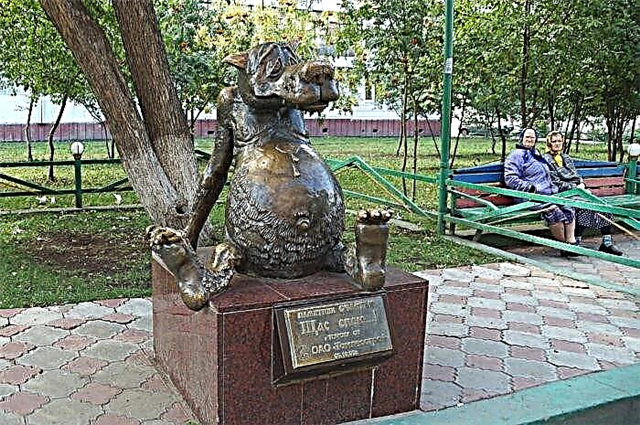
Monument to Chekhov
It was installed in Tomsk on the banks of the Tom River in 2004. The two-meter bronze figure of the writer is depicted in a somewhat caricatured form - he is standing barefoot, in a coat and a funny hat, in a skewed pince-nez, and an umbrella behind his back. Experts say that this is a kind of "comic" revenge of the townspeople for the unflattering statements of Anton Chekhov in 1890 against their beloved city. There is a belief among students: if you rub the nose of a monument, you will be lucky to pass the exam.

Monument to home slippers
A pair of worn bronze house slippers on a low pedestal at the entrance to the Tomsk hotel is a symbol of home comfort and hospitality, for which the city's residents are famous. The original monument was invented by the Tomsk sculptor O. Kislitsky and installed in 2006. The inscription on it encourages all guests of Tomsk to feel at home. Anyone can try on funny slippers - their length is 32 cm.

Monument to a Football Fan
It was installed in 2006 in the middle of the tribune at the Trud stadium. The prototype for the creation of the monument was a very real photo of a fan of the 50s - 60s of the last century, enthusiastically following the progress of a football match. In his hand he holds one of the issues of Football-Hockey, a popular sports newspaper in the USSR. An unusual bronze sculpture was installed in honor of the 50th anniversary of Tomsk football. Its author was the famous sculptor Leonty Usov in the city.

Camp garden
Natural monument. Park zone with an area of 40 hectares within the boundaries of Tomsk, on the banks of the Tom River. In the XVIII-XIX centuries. on this place were located military camps of infantrymen, which is why such an unusual name. A memorial complex is installed here - a sculpture of the Motherland with a son, the Eternal Flame and steles with the names of the dead Tomsk residents. During excavations on the territory of the garden, archaeological finds from the Paleolithic and Middle Ages were discovered. The park is home to a large population of squirrels.

Kirek lake
Natural monument. It is located near the village of Kirek, in the Tomsk reserve. The area is 49 hectares, the average depth is 2.7 m. It is famous for warm transparent water, rich in ichthyofauna and large reserves of medicinal sapropelic silt. In some places, the thickness of its layer reaches 10 m. The reservoir is surrounded by coniferous and deciduous forests, the coastal part is overgrown with lilies and water lilies. There is the only species of amphibians in Siberia that has managed to adapt to the harsh climate - the four-fingered newt.

Semiluzhensky Cossack prison
In the 17th century, there was a Cossack outpost in Semiluzhki. Local resident Vladimir Ilyin recreated all the buildings of that time with his own efforts - fortress walls, towers with bells, huts, a church, a smithy, wells, cannons, as well as items of peasant life. Excursions are held in the prison, introducing the architecture of the Cossack settlement and the traditions of the Russian people. As well as a variety of master classes, wedding ceremonies, festivals of folk art.

Seversky Zoo
The zoo in Seversk is currently the only one in the entire region. Its history began in the 60s, when a small corner of wildlife was created on the territory of the local culture park. In the future, the collection of animals has grown significantly and now numbers 220 species, including exotic lemurs, crocodiles, monkeys, camels, ostriches, etc. The zoo specialists conduct exciting excursions for children and adults. A petting zoo was opened.

Chulym river
A large tributary of the Ob. Length - 1.8 thousand km. It originates in the mountains of Khakassia, then acquires a flat character. It has picturesque shores, the flora is represented by conifers and deciduous species, various grasses. The water surface is covered with white and yellow water lilies, a lot of algae. It is famous for its notable year-round fishing. One of the five rivers in the country where sterlet and sturgeon come to spawn. Popular with outdoor enthusiasts.

Larinsky landscape reserve
It is located 6 km from the village of Vershinino, in the south of the Tomsk region. Created in 1993. The area is 1.6 thousand hectares. Includes a section of plain taiga, turning into mountain taiga. The most picturesque objects are the Tomsk mountains, the Tugoyakovka river, one of the cleanest in the region. There are several natural monuments, the most famous is the Dizvezdny Key. It flows out of a grotto on a hill and forms a small waterfall that cascades over moss-covered travertine steps.

Lake Mirnoe
The largest lake in the region. Natural monument. It is located in the Parabel region, in a remote area.Sometimes you can only get to it by helicopter or snowmobile. Square - 18.3 km2, maximum depth - 4 m. On all sides the reservoir is surrounded by swamps and taiga. There are mineral springs along the shores, there are beaches equipped for recreation and places for fishing. The ichthyofauna is quite diverse, including rare whitefish and ripuses.







